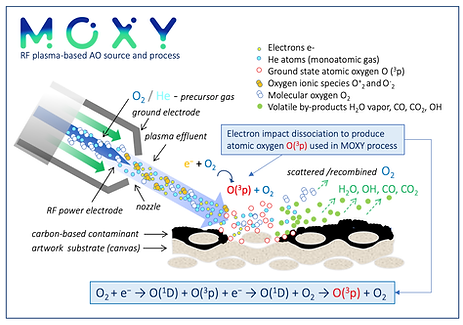top of page


images: Alamy, ESA, Moderna Museet, NASA, Shutterstock, Pixabay, Wikimedia Commons
FROM SPACE TO GREEN TECHNOLOGIES FOR CULTURAL HERITAGE
MOXY Project Embarks Upon the Development of Oxygen-based Non-Contact Green Cleaning Systems
“The Moxy project stands alone in the world as it embarks upon the development of new and non-traditional methods of art restoration that may enable cleaning of artworks not previously possible through the use of atomic oxygen” – with these words NASA scientists Bruce Banks and Sharon Miller, who pioneered atomic oxygen in art conservation, opened the MOXY project kick-off meeting via a virtual bridge between NASA Glenn Center and Ghent University, the coordinator of the four-year European MOXY project, which started on November 1, 2022.
AO technology may offer a breakthrough to remove diverse carbon-based contaminants (dust, soot, combustion pollutants, grease, fingerprints, organic and biological contaminants) with a non-contact and chemical-free process. Nascent (atomic) oxygen (AO), a single oxygen atom, is different from the O2 oxygen molecule that we breathe, and even more different than ozone O3. AO is a space environment material, typically found at 80 - 1000 km in altitude where it is produced photochemically by the dissociation of molecular oxygen O2 by UV radiation.


Atomic oxygen content at 400 km orbit. A green band of oxygen glow is visible over Earth's curve. Images: S. Miller, NASA.


Defaced A. Warhol painting during treatment using an experimental atomic oxygen generator designed and constructed by B. Banks and S. Miller at NASA John Glenn Research Center. Detail of NASA atmospheric atomic oxygen apparatus nozzle with AO effluent. Images: NASA
Bruce Banks and Sharon Miller who pioneered AO in the cultural heritage field spoke at the MOXY kick-off meeting at Ghent University on Nov 7, 2022.
.jpg)
Silver interconnector 25 μm from European Retrievable Carrier EURECA. Oxidized silver is flaked off and exposes the underlying fresh material which is oxidized again. Photo: ESA. Rooij, A. 2010. Corrosion in Space. Doi: 10.1002/9780470686652.eae242.
In space, AO is a major erosion hazard for spacecraft materials. However, the destructive power of AO in space can be harnessed for non-contact green cleaning of cultural heritage objects. The AO innovation started with pioneering work by NASA scientists Sharon Miller and Bruce Banks in the 1990s to remove lipstick defacement from an early, hand-painted Andy Warhol painting “Bathtub” (1961), Andy Warhol Museum, Pittsburgh PA, United States, and testing AO on smoke and fire-damaged art materials. To apply AO in conservation, the initial threshold challenge is how to deliver it to the artwork surface. AO is extremely short-lived on the ground (a few milliseconds).

1998 B. Banks AO cleaning test removing lipstick from Titanium White acrylic paint. Image: NASA (left). 2022 test removing lipstick from Titanium White acrylic paint samples (2x2 cm), using AO and space environment simulator LEOX at the European Space Agency ESA. The left side was masked from AO, which removed organic compounds from the lipstick, but not the inorganic components, such as red iron oxides, which typically are not affected, but the loose powdery lipstick particulate was easily dry removed in a second step, marked with arrows. Same approach was taken by NASA treating Warhol painting. Images: RUPT, Ghent University,
NASA and ESA have typically conducted AO tests e using low-pressure chambers, where AO is produced using radio-frequency (RF) field, laser detonation, and other methods. However, low-pressure methods remain impractical for conservation because of the size and cost of the system, lack of access the object while under treatment, and the vacuum itself can be disruptive to many art materials. To achieve a breakthrough, MOXY researchers will pursue an alternative atmospheric approach, where AO is produced and then used instantaneously.
No contact, no solvents, no liquids, no harm to health and the environment, and no waste
In the non-contact AO cleaning process, developed by MOXY, the ground state atomic oxygen is an essential active material. Upon meeting the surface, AO reacts instantly with the first carbon-based materials encountered – carbon/organic soiling - producing small amount of "thin air" - harmless volatile byproducts, such as CO, CO2, and H2O vapours.

Non-contact plasma-generated atomic oxygen cleaning process of soot on canvas. Scheme (above) and image of half-cleaned cotton canvas (below), 2023. Images: RUPT, Ghent University


Soot half-removed from plaster under the Hirox 3D microscope. S11 area A: pristine, B: soot, C: soot cleaned with AO; D: pristine, treated with AO. Photo: RUPT UGent.

Testing atmospheric AO system in progress at Ghent University. SEM: paper, yellow ochre (Fe2O3-H2O gouache paint: pristine (upper left), soiled with soot (upper center), and cleaned (upper right). Gouache sample with a cleaned spot (lower left, white dotted circle) using plasma-generated AO. The precursor gas O2 (2%) in He, flow 4 l/min. Cleaning pace: 8 s / 5 mm2 circa. Photo: RUPT UGent.

To explore AO effects on typical cultural heritage materials, 39 mockups were made: plaster, limestone, acrylic paint, canvas, pastel, paper were prepared and for the first time experimented at ESA using the space environment simulator ESTEC TEC-QEE LEOX. The simulator consists of a vessel composed of three compartments separated by an electro-pneumatic valve and an orifice in the main chamber where the samples are exposed to 99% AO under low-pressure conditions, using IR CO2 laser detonation. Photo: ESA.

bottom of page